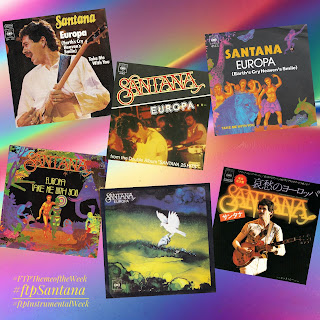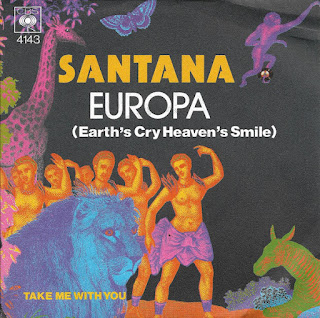Publicació: 26 de març de 1976
Àlbum: Amigos
A mitjans dels anys setanta, el món canviava. El rock s’expandia cap al jazz, el soul flirtejava amb el funk, i Carlos Santana explorava noves dimensions emocionals i musicals. Entre el xiuxiueig d’una guitarra i un lament còsmic, va néixer “Europa (Earth’s Cry Heaven’s Smile)”.
Però no va començar com la balada serena i celestial que coneixem avui. La primera espurna de “Europa” va sorgir d’un lloc inesperat: un moment de dolor. Santana va presenciar com una amiga proper patia un mal viatge de mescalina, un episodi inquietant que el va colpir profundament. D’aquella experiència intensa en va sortir una composició titulada “The Mushroom Lady’s Coming to Town”—un esbós cru, ple d’emoció i boira psicodèlica. Ja contenia el lick inicial de guitarra que acabaria definint “Europa”. Però Santana el va arxivar. El moment va passar, i la peça es va fondre en silenci.
Mesos després, a Manchester (Anglaterra), durant una gira amb Earth, Wind & Fire, Santana va retrobar aquell motiu melòdic—com si li tornés a parlar des del record. Aquesta vegada no estava sol. El teclista Tom Coster, col·laborador habitual, era amb ell. Junts van modelar i polir aquella música fins a convertir-la en alguna cosa més refinada, més universal. “Europa” va renéixer, transformada de l’angoixa psicodèlica a la transcendència melòdica.
Li van posar un títol poètic: “Europa (Earth’s Cry Heaven’s Smile)”—“El crit de la Terra, el somriure del Cel”. El nom recollia exactament allò que la música expressava: dolor i guariment, desesperació i bellesa, ombra i llum.
Quan es va publicar el 1976 com a part del setè àlbum d’estudi de Santana, “Amigos”, “Europa” no estava pensada per ser un èxit. L’àlbum obria un nou capítol pel grup, amb una marcada fusió de jazz llatí i espiritualitat. Als EUA, la recepció va ser discreta: el senzill “Let It Shine” gairebé no va entrar a les llistes. Però “Europa” va ser una cosa més profunda. Quan es va llançar com a single internacional, va triomfar: va arribar al #1 a les llistes d’Espanya el juliol de 1976 i va entrar al top 10 arreu del continent. Va tocar una fibra. No era una cançó per ballar o cantar. Era una cançó de sentiment.
Sense lletra, Santana deixava que la seva guitarra parlés—plorant, planant, xiuxiuejant veritats que només el so pot transmetre. La guitarra plorava per la Terra, i en aquell plor, el Cel somreia. “Europa” és avui una de les composicions més estimades de Santana. És una peça habitual dels seus concerts, sovint allargada i transformada, però sempre reconeixible per aquella frase d’obertura plena de desig i lluminositat.
Allò que va començar com un lament psicodèlic es va convertir en una melodia atemporal—una pregària sense paraules, una elegia, un gest de guarició en forma de música. Santana va dir una vegada que la música s’ha de sentir “com una abraçada, com un petó de l’univers”. “Europa” és exactament això.
SANTANA - EUROPA (EARTH’S CRY HEAVEN’S SMILE)
Released: March 26, 1976
Album: Amigos
In the mid-1970s, the world was shifting. Rock was branching into jazz, soul was flirting with funk, and Carlos Santana was exploring new emotional and musical dimensions. Somewhere between a guitar’s whisper and a cosmic lament, “Europa (Earth’s Cry Heaven’s Smile)” was born.
But it didn’t start as the serene, celestial ballad we know today. The earliest spark of “Europa” came from an unexpected place: a moment of pain. Santana watched a close friend spiral into a bad mescaline trip, a haunting episode that deeply affected him. Out of that intense experience came a composition titled “The Mushroom Lady’s Coming to Town”—a raw, swirling sketch of melody, emotion, and psychedelic haze. It contained the opening guitar lick that would later define “Europa”. But Santana put it away. The moment passed, and the piece faded into silence.
Months later, in Manchester, England, Santana was on tour with Earth, Wind & Fire, a band full of fire and rhythm. Backstage or perhaps during a soundcheck, he unearthed that melody again, almost like a memory whispering back. This time, he wasn’t alone. Keyboardist Tom Coster—a longtime collaborator—was there, and together, they shaped and polished the piece into something more refined, more universal. “Europa” was reborn, transformed from psychedelic anguish into melodic transcendence.
They renamed it “Europa (Earth’s Cry Heaven’s Smile)”—a title as poetic as the music itself. It captured everything the composition stood for: sorrow and healing, anguish and beauty, despair met by light.
Released in 1976 as part of Santana’s seventh studio album, “Amigos”, “Europa” wasn’t initially meant to be a hit. The album itself marked a new chapter for the band—one tinged with Latin jazz fusion and spiritual undertones. While the U.S. took mild notice, with the single “Let It Shine” barely grazing the charts, “Europe” heard something deeper. When it was released as a single overseas, it soared—reaching #1 on the Spanish Singles Chart in July 1976 and becoming a top ten hit across the continent. It struck a chord. It wasn’t a song you danced to or sang along with. It was a song you felt.
With no lyrics, Santana let his guitar speak—weeping, soaring, whispering truths only sound can carry. The guitar cried for the earth, and somewhere in that cry, heaven smiled back. “Europa” stands as one of Santana’s most beloved compositions. It is a standard in his live performances, often extended and reshaped, but always recognizable by that longing, luminous opening phrase.
What began as a psychedelic lament became a timeless melody—a prayer without words, an elegy, a healing touch in musical form. Santana once said that music should be felt “like a hug, like a kiss from the universe.” “Europa” is exactly that.





Cap comentari:
Publica un comentari a l'entrada